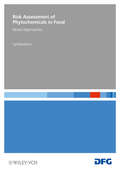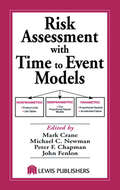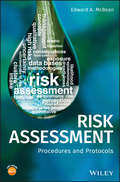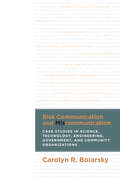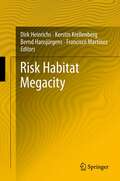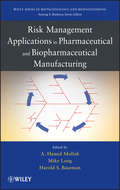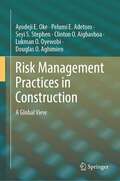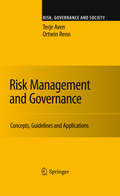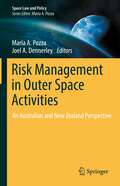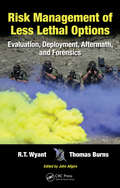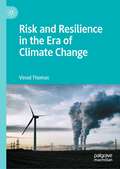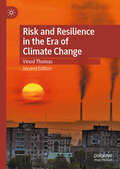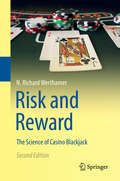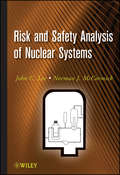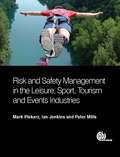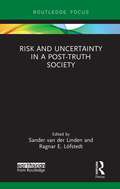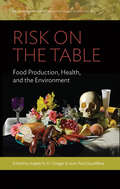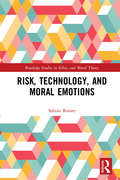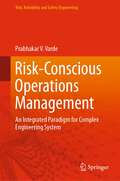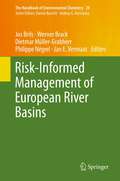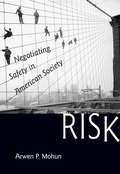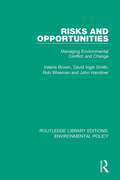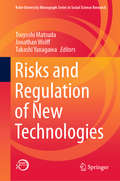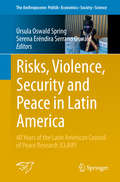- Table View
- List View
Risk Assessment of Phytochemicals in Food: Novel Approaches (Forschungsberichte (DFG))
by Dfg Senate Commission On Food SafetyProviding the scientific background on the risk and safety assessment of toxicity in phytochemicals in everyday food, this monograph contains the pros and cons of 20 testing methods, with comments by the internationally acknowledged and independent DFG Senate Commission on Food Safety. Supplemented by 40 poster contributions on phytochemicals and their effects.
Risk Assessment with Time to Event Models (Environmental and Ecological Risk Assessment)
by Michael C. Newman Mark Crane Peter F. Chapman John FenlonHow can environmental regulators use information on 48-hour toxicity tests to predict the effects of a few minutes of pollution? Or, at the other extreme, what is the relevance of 96-hour toxicity data for organisms that may have been exposed to a pollutant for six months or more? Time to event methods are the key to answering these types of questi
Risk Assessment: Procedures and Protocols
by Edward A. McBeanRisk Assessment describes the methodologies, the math, and assumptions needed in risk assessment calculations and explores the various statistical analysis procedures that are used for estimating the parameters employed in risk assessment approaches. The author--a noted expert in the field--outlines a logical step-by-step approach to assessment: Identify a hazard; Analyze the risk associated with that hazard; and Determine if the elimination, or control of the risk is warranted. The text puts the focus on assessing environmental risk and describes the basics used in hypothesis testing to determine when there are differences in environmental quality at various locations.
Risk Communication and Miscommunication: Case Studies in Science, Technology, Engineering, Government, and Community Organizations
by Carolyn BoiarskyEffective communication can help prevent or minimize damage from environmental disasters. In Risk Communication and Miscommunication, Carolyn Boiarsky teaches students, technical writers, public affairs officers, engineers, scientists, and governmental officials the writing and communication skills necessary for dealing with environmental and technological problems that could lead to major crises. Drawing from research in rhetoric, linguistics, technical communication, educational psychology, and web design, Boiarsky provides a new way to look at risk communication. She shows how failing to consider the readers’ needs and the rhetorical context in which a document is read can be catastrophic and how anticipating those needs can enhance effectiveness and prevent disaster. She examines the communications and miscommunications of original e-mails, memos, and presentations about various environmental disasters, including the Columbia space shuttle breakup and the BP/Deepwater Horizon oil rig explosion, and successes, such as the Enbridge pipeline expansion and the opening of the Mississippi Spillway, offering recommendations for effective communication. Taking into account the growing need to communicate complex and often controversial issues across vast geographic and cultural spaces with an ever-expanding array of electronic media, Risk Communication and Miscommunication provides strategies for clear communication of data, ideas, and procedures to varied audiences to prevent or minimize damage from environmental incidents.
Risk Habitat Megacity
by Bernd Hansjürgens Dirk Heinrichs Francisco Martínez Kerstin KrellenbergMegacity development and the inherent risks and opportunities for humans and the environment is a theme of growing urgency in the 21st century. Focusing on Latin America where urbanization is most advanced, this book studies the complexity of a 'mega-urban system' and explores interrelations between sectors and issues by providing an in-depths study of one particular city, Santiago de Chile. The book attempts to (i) focus on the emergence of risk in megacities by analyzing risk elements, (ii) evaluate the extent and severity of risks, (iii) develop strategies to cope with adverse risks, and (iv) to guide urban development by combining concepts with empirical evidence. Drawing on the work of an interdisciplinary and international consortium of academic and professional partners, the book is written for scholars in cross-cutting areas of urban, sustainability, hazard, governance and planning research as well as practitioners from local, regional and international organizations.
Risk Management Applications in Pharmaceutical and Biopharmaceutical Manufacturing
by Harold Baseman Mike Long Hamid MollahSets forth tested and proven risk management practices in drug manufacturingRisk management is essential for safe and efficient pharmaceutical and biopharmaceutical manufacturing, control, and distribution. With this book as their guide, readers involved in all facets of drug manufacturing have a single, expertly written, and organized resource to guide them through all facets of risk management and analysis. It sets forth a solid foundation in risk management concepts and then explains how these concepts are applied to drug manufacturing.Risk Management Applications in Pharmaceutical and Biopharmaceutical Manufacturing features contributions from leading international experts in risk management and drug manufacturing. These contributions reflect the latest research, practices, and industry standards as well as the authors' firsthand experience. Readers can turn to the book for:Basic foundation of risk management principles, practices, and applicationsTested and proven tools and methods for managing risk in pharmaceutical and biopharmaceutical product manufacturing processesRecent FDA guidelines, EU regulations, and international standards governing the application of risk management to drug manufacturingCase studies and detailed examples demonstrating the use and results of applying risk management principles to drug product manufacturingBibliography and extensive references leading to the literature and helpful resources in the fieldWith its unique focus on the application of risk management to biopharmaceutical and pharmaceutical manufacturing, this book is an essential resource for pharmaceutical and process engineers as well as safety and compliance professionals involved in drug manufacturing.
Risk Management Practices in Construction: A Global View
by Ayodeji E. Oke Clinton O. Aigbavboa Pelumi E. Adetoro Seyi S. Stephen Lukman O. Oyewobi Douglas O. AghimienThis volume describes risk management practices in the construction industry in selected countries, with an emphasis on developing countries and how these countries can learn from the practices in more developed ones. Risk management in the construction industry can be difficult to understand due to the various complex procedures that are involved and to the unique concerns and contexts associated with each project. The industry has been a key contributor to the economic and social development of many countries of the world and is increasingly incorporating sustainability into its practices. However it is plagued by various risks that can affect the quality, cost, time and overall sustainability of projects. Therefore, there is need to effectively manage risk in order to ensure timely completion of construction projects in good quality and within budget, which in turn results in more efficient and often more sustainable practices. The book is divided into four parts. The first section features a primer on risk management practices as they pertain to the construction industry. The second part dives in to describe risk management in selected developing countries, including Malaysia, Qatar, Saudi-Arabia, South Africa, Sri-Lanka and Tanzania, as well as the city of Hong Kong. The third section describes the construction risk management practices of a selection of more developed countries with known risk management institutes and established practices of risk management. These countries include Australia, Canada, Sweden and United States of America. The fourth part offers a general overview of the definition, concepts and process of risk management based on reviewed literature. It also discusses the benefits of effective risk management to clients and to project teams, especially from the perspective of ensuring sustainability. This last section also summarizes the risk management practices in both developing and developed countries for the purpose of improving the practices in the former by learning from the latter.
Risk Management and Governance: Concepts, Guidelines and Applications
by Ortwin Renn Terje AvenRisk is a popular topic in many sciences - in natural, medical, statistical, engineering, social, economic and legal disciplines. Yet, no single discipline can grasp the full meaning of risk. Investigating risk requires a multidisciplinary approach. The authors, coming from two very different disciplinary traditions, meet this challenge by building bridges between the engineering, the statistical and the social science perspectives. The book provides a comprehensive, accessible and concise guide to risk assessment, management and governance. A basic pillar for the book is the risk governance framework proposed by the International Risk Governance Council (IRGC). This framework offers a comprehensive means of integrating risk identification, assessment, management and communication. The authors develop and explain new insights and add substance to the various elements of the framework. The theoretical analysis is illustrated by several examples from different areas of applications.
Risk Management in Outer Space Activities: An Australian and New Zealand Perspective (Space Law and Policy)
by Maria A. Pozza Joel A. DennerleyRisk Management in Outer Space Activities assesses selected risks associated with space activities, from an Australian and New Zealand perspective. The book explores the rise of commercial space activities and considers the development of Australia and New Zealand’s regulatory frameworks, and how they are equipped to address new and emerging risks in the space sector.The book examines the juxtaposition of international space law against the domestic legal regimes of Australia and New Zealand, and how these regulatory frameworks are designed to create governance mechanisms to control space risk. Both national jurisdictions approach space risk from the perspective of liability and international legal obligations, but as a result of their different historical space trajectories, their risk approaches differ. This is illustrated by research that suggests that from an Australian point of view, much of its space industry development has been influenced by Cold War era military and national security concerns. On the other hand, the New Zealand perspective is grounded on the rapid market-led commercial development that is currently underway in the country.The book examines a variety of risks that can and do emerge in the course of undertaking space activities. It does this by presenting a series of space risk case studies. There are chapters devoted to examining commercial space risks, space insurance, the risks posed by space debris, cybersecurity and space assets, light pollution as a risk for astronomy and the risks inherent in landing objects on the Moon. The work contained in this book is intended to provide a clear, practical and informed approach to understanding risk management in outer space activities. It will appeal to policy makers, risk professionals, space lawyers, national space agencies as well as academics, researchers and students
Risk Management of Less Lethal Options: Evaluation, Deployment, Aftermath, and Forensics
by R.T. Wyant Thomas BurnsForce used to quell out-of-control demonstrations or detain unruly individuals can result in litigation and bad press for law enforcement agencies. Injury or loss of life can best be avoided if agencies have accurate knowledge and proper training in less lethal options. Risk Management of Less Lethal Options: Evaluation, Deployment, Aftermath, and
Risk and Resilience in the Era of Climate Change
by Vinod ThomasThis book presents essential insights on the interaction between rising risks and raising the bar for resilience during the climate crisis. Its timeliness lies in applying important findings on risk and resilience to runaway climate change. When risk and resilience are brought together in the context of climate catastrophes, three key messages emerge.The first is that accounting for the root causes of these calamities, and not just their symptoms, is essential to slowing the spike in these events. It is therefore vital to link carbon emissions from human activity to the sharp rise in climate disasters globally. The second is that growth economics and policy must factor in the failure of governments and businesses to tackle spillover harm from economic activities, as seen dramatically with global warming. With climate risks rising, this calls for a fundamental revision in the teaching and practice of business and economics. And third, prevention must become a far bigger part of resilience building, with greater preparedness for more intense destruction built into interventions. This emphasis on prevention deems disaster recovery as not just returning to how things were but building back better.
Risk and Resilience in the Era of Climate Change
by Vinod ThomasThis book presents essential insights on the interaction between rising risks and raising the bar for resilience during the climate crisis. Its timeliness lies in applying important findings on risk and resilience to runaway climate change. When risk and resilience are brought together in the context of climate catastrophes, three key messages emerge. The first is that accounting for the root causes, and not just their symptoms, is essential to slowing these events. It is therefore vital to link carbon emissions from human activity to the sharp rise in climate disasters globally. The second is that growth economics and policy must factor in the failure of governments and businesses to tackle spillover harm from economic activities, as seen strikingly with global warming AND BIODIVERSITY LOSS. With climate risks rising, this calls for a fundamental revision of the framing of growth in the teaching and practice of business and economics. And third, prevention must become a far bigger part of resilience building, with preparedness to avert or handle tougher eventualities built into interventions. Emphasis on prevention deems disaster recovery as not just returning to how things were but building back better.
Risk and Reward: The Science of Casino Blackjack
by N. Richard WerthamerFor decades, casino gaming has been steadily increasing in popularity worldwide. Blackjack is among the most popular of the casino table games, one where astute choices of playing strategy can create an advantage for the player. RISK AND REWARD analyzes the game in depth, pinpointing not just its optimal strategies but also its financial performance, in terms of both expected cash flow and associated risk. The book begins by describing the strategies and their performance in a clear, straightforward style. The presentation is self-contained, non-mathematical, and accessible to readers at all levels of playing skill, from the novice to the blackjack expert. Careful attention is also given to simplified, but still nearly optimal strategies that are easier to use in a casino. Unlike other books in the literature the author then derives each aspect of the strategy mathematically, to justify its claim to optimality. The derivations mostly use algebra and calculus, although some require more advanced analysis detailed in supporting appendices. For easy comprehension, formulae are translated into tables and graphs through extensive computation. This book will appeal to everyone interested in blackjack: those with mathematical training intrigued by its application to this popular game as well as all players seeking to improve their performance.
Risk and Safety Analysis of Nuclear Systems
by John C. Lee Norman J. MccormickThe book has been developed in conjunction with NERS 462, a course offered every year to seniors and graduate students in the University of Michigan NERS program. The first half of the book covers the principles of risk analysis, the techniques used to develop and update a reliability data base, the reliability of multi-component systems, Markov methods used to analyze the unavailability of systems with repairs, fault trees and event trees used in probabilistic risk assessments (PRAs), and failure modes of systems. All of this material is general enough that it could be used in non-nuclear applications, although there is an emphasis placed on the analysis of nuclear systems. The second half of the book covers the safety analysis of nuclear energy systems, an analysis of major accidents and incidents that occurred in commercial nuclear plants, applications of PRA techniques to the safety analysis of nuclear power plants (focusing on a major PRA study for five nuclear power plants), practical PRA examples, and emerging techniques in the structure of dynamic event trees and fault trees that can provide a more realistic representation of complex sequences of events. The book concludes with a discussion on passive safety features of advanced nuclear energy systems under development and approaches taken for risk-informed regulations for nuclear plants.
Risk and Safety Management in the Leisure, Events, Tourism and Sports Industries
by Mark Piekarz Peter Mills Ian JenkinsThe management of risk and safety is not simply a matter of trying to remove risks, but is necessary and vital to these industries. Sensible risk management is concerned with making the most of the positive opportunities or reducing the negative risks. This books shows how the absence of explicit risk practices is not necessarily an absence of risk management, and how many existing operational and strategic practices can be understood as part of a process of risk and safety management. Its main objective is to develop greater clarity in the communication of risks and the development of safety programmes, illustrating how organisations can use a single language of risk, relevant for all levels of management and areas of operation.
Risk and Uncertainty in a Post-Truth Society (Earthscan Risk in Society)
by Sander van der Linden Ragnar E. LöfstedtThis edited volume looks at whether it is possible to be more transparent about uncertainty in scientific evidence without undermining public understanding and trust. With contributions from leading experts in the field, this book explores the communication of risk and decision-making in an increasingly post-truth world. Drawing on case studies from climate change to genetic testing, the authors argue for better quality evidence synthesis to cut through the noise and highlight the need for more structured public dialogue. For uncertainty in scientific evidence to be communicated effectively, they conclude that trustworthiness is vital: the data and methods underlying statistics must be transparent, valid, and sound, and the numbers need to demonstrate practical utility and add social value to people’s lives. Presenting a conceptual framework to help navigate the reader through the key social and scientific challenges of a post-truth era, this book will be of great relevance to students, scholars, and policy makers with an interest in risk analysis and communication.
Risk on the Table: Food Production, Health, and the Environment (Environment in History: International Perspectives #21)
by Angela N. H. Creager and Jean-Paul GaudillièreOver the last century, the industrialization of agriculture and processing technologies have made food abundant and relatively inexpensive for much of the world’s population. Simultaneously, pesticides, nitrates, and other technological innovations intended to improve the food supply’s productivity and safety have generated new, often poorly understood risks for consumers and the environment. From the proliferation of synthetic additives to the threat posed by antibiotic-resistant bacteria, the chapters in Risk on the Table zero in on key historical cases in North America and Europe that illuminate the history of food safety, highlighting the powerful tensions that exists among scientific understandings of risk, policymakers’ decisions, and cultural notions of “pure” food.
Risk on the Table: Food Production, Health, and the Environment (Environment in History: International Perspectives #21)
by Angela N. H. Creager and Jean-Paul GaudillièreOver the last century, the industrialization of agriculture and processing technologies have made food abundant and relatively inexpensive for much of the world’s population. Simultaneously, pesticides, nitrates, and other technological innovations intended to improve the food supply’s productivity and safety have generated new, often poorly understood risks for consumers and the environment. From the proliferation of synthetic additives to the threat posed by antibiotic-resistant bacteria, the chapters in Risk on the Table zero in on key historical cases in North America and Europe that illuminate the history of food safety, highlighting the powerful tensions that exists among scientific understandings of risk, policymakers’ decisions, and cultural notions of “pure” food.
Risk, Technology, and Moral Emotions (Routledge Studies in Ethics and Moral Theory)
by Sabine RoeserRisks arising from technologies raise important ethical issues. Although technologies such as nanotechnology, biotechnology, ICT, and nuclear energy can improve human well-being, they may also convey risks for our well-being due to, for example, abuse, unintended side-effects, accidents, and pollution. As a consequence, technologies can trigger emotions, including fear and indignation, which often leads to conflicts between stakeholders. How should we deal with such emotions in decision making about risky technologies? This book offers a new philosophical theory of risk emotions, arguing why and how moral emotions should play an important role in decisions surrounding risky technologies. Emotions are usually met with suspicion in debates about risky technologies because they are seen as contrary to rational decision making. However, Roeser argues that moral emotions can play an important role in judging ethical aspects of technological risks, such as justice, fairness, and autonomy. This book provides a novel theoretical approach while at the same time offering concrete recommendations for decision making about risky technologies. It will be of interest to those working in different areas of philosophy—such as ethics, decision theory, philosophy of science, and philosophy of technology—as well as scholars in the fields of psychology, public policy, science and technology studies, environmental ethics, and bioethics.
Risk-Conscious Operations Management: An Integrated Paradigm for Complex Engineering System (Risk, Reliability and Safety Engineering)
by Prabhakar V. VardeThis book presents various concepts and applications related to risk-conscious operations management. It also provides an overview of the risk-based engineering – fundamental to the concept of risk-conscious operations management. It presents the reliability concept to support Dependency Modelling, which includes hardware systems structures and components for reliability improvement and risk reduction. The book further develops and builds attributes and model for risk-conscious culture – critical to characterize operational approach to risk and presents human factor modelling, where it works on developing an approach for human error precursor analysis. This book will be useful for students, researchers, academicians and professionals working on identifying risk and reliability issues in complex safety and mission critical systems. It will also be beneficial for industry risk-and-reliability experts and operational safety staff working in the complex engineering systems.
Risk-Informed Management of European River Basins
by Werner Brack Philippe Négrel Dietmar Müller Jos Brils Jan E. VermaatThe growing impacts of economic activities and climate change on the conditions of rivers throughout the world, require a new, integrated approach towards river basin management, an approach that can also cope with an uncertain future. In this volume, leading European scientists and representatives of major stakeholder groups present risk-informed management as this new approach, as developed in the European Commission-funded project RISKBASE. It aims to improve the ecological quality of river basins and thus to sustain the goods and services they provide for the benefit of society. Risk-informed management involves the integrated application of three key-principles: · Being well informed · Managing adaptively · Pursuing a participatory approach The authors explain and underpin these principles in detail, offer inspiring examples from practice and connect them to the implementation of the European Water Framework Directive (WFD). This book is intended for scientists, consultants and practitioners concerned about river basins, world-wide, as well as the drafters and implementers of the WFD River Basin Management Plans.
Risk: Negotiating Safety in American Society
by Arwen P. MohunHow have Americans confronted, managed, and even enjoyed the risks of daily life?Winner of the Ralph Gomory Prize of the Business History Conference“Risk” is a capacious term used to describe the uncertainties that arise from physical, financial, political, and social activities. Practically everything we do carries some level of risk—threats to our bodies, property, and animals. How do we determine when the risk is too high? In considering this question, Arwen P. Mohun offers a thought-provoking study of danger and how people have managed it from pre-industrial and industrial America up until today. Mohun outlines a vernacular risk culture in early America, one based on ordinary experience and common sense. The rise of factories and machinery eventually led to shocking accidents, which, she explains, risk-management experts and the “gospel of safety” sought to counter. Finally, she examines the simultaneous blossoming of risk-taking as fun and the aggressive regulations that follow from the consumer-products-safety movement. Risk and society, a rapidly growing area of historical research, interests sociologists, psychologists, and other social scientists. Americans have learned to tame risk in both the workplace and the home. Yet many of us still like amusement park rides that scare the devil out of us; they dare us to take risks.
Risks and Opportunities: Managing Environmental Conflict and Change (Routledge Library Editions: Environmental Policy #5)
by Valerie Brown John Handmer David Ingle Smith Rob WisemanFirst published in 1995. Managing today’s rapidly changing environment inevitably involves managing conflicts between the demands of development and conservation; the needs of the present and of the future; and between different community interests, professional positions and political priorities. Risks and Opportunities provides both a guide to managing environmental change, and a training manual to pave the way to successful conflict resolution. It explores the full range of potential conflicts and looks at various methods for their resolution. It covers the who, what, why and when of managing change, and emphasizes the need to develop an active and strategic approach which indemnifies the interests and abilities of all the stakeholders. The book’s detailed case studies provide in-depth material on the conflicting uses of urban, agricultural and natural environments, and the self-teaching guide and exercises will enable individual readers and organizations to acquire the necessary practical and team-building skills.
Risks and Regulation of New Technologies (Kobe University Monograph Series in Social Science Research)
by Jonathan Wolff Takashi Yanagawa Tsuyoshi MatsudaHow should we proceed with advanced research of humanities and social sciences in collaboration? What are the pressing issues of this new trend in a cataclysmic time for civilization? This book, originated with a Japan Society for the Promotion of Science (JSPS) Topic-Setting Program, addresses these challenging questions in four parts for innovating twenty-first-century humanities and social sciences. It broadens the horizon for reviewing multi-disciplinary landscapes of risks and regulation of new technologies by focusing on paradigmatic cases from the fields of life and environment. Here, genome editing for reproductive treatment and renewable energy under the constraint of climate change in Japanese and global contexts are involved. The volume comprises a combination of topics and aspects such as public policy and philosophy of science, medicine and law, climate ethics, and the economics of electricity. This edited collection will thus motivate forward-thinking readers across the diverse spectrum of social sciences and humanities to survey themes of their own interests in multi-disciplinary studies. In so doing, they can explore the evolving frontiers of those disciplines and the depths of individual contributions by experts in philosophy, ethics, law, economics, and science, technology, and society (STS), including bioscience.
Risks, Violence, Security and Peace in Latin America: 40 Years of the Latin American Council of Peace Research (CLAIP) (The Anthropocene: Politik—Economics—Society—Science #24)
by Úrsula Oswald Spring Serena Eréndira Serrano OswaldThis book analyses the war against drugs, violence in streets, schools and families, and mining conflicts in Latin America. It examines the nonviolent negotiations, human rights, peacebuilding and education, explores security in cyberspace and proposes to overcome xenophobia, white supremacy, sexism, and homophobia, where social inequality increases injustice and violence. During the past 40 years of the Latin American Council for Peace Research (CLAIP) regional conditions have worsened. Environmental justice was crucial in the recent peace process in Colombia, but also in other countries, where indigenous people are losing their livelihood and identity. Since the end of the cold war, capitalism aggravated the life conditions of poor people. The neoliberal dismantling of the State reduced their rights and wellbeing in favour of enterprises. Youth are not only the most exposed to violence, but represent also the future for a different management of human relations and nature.
